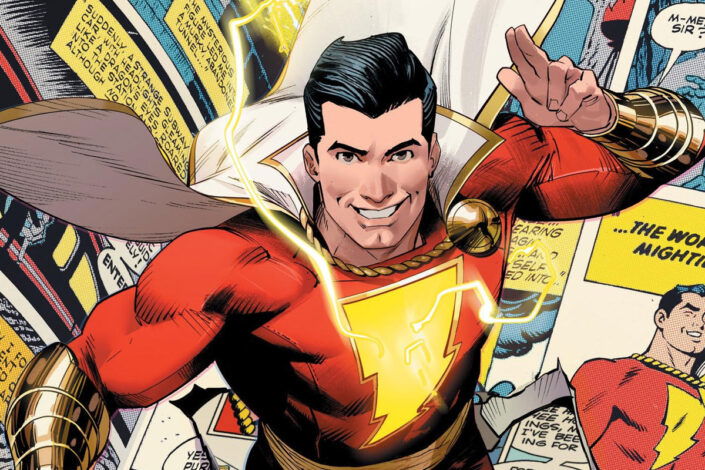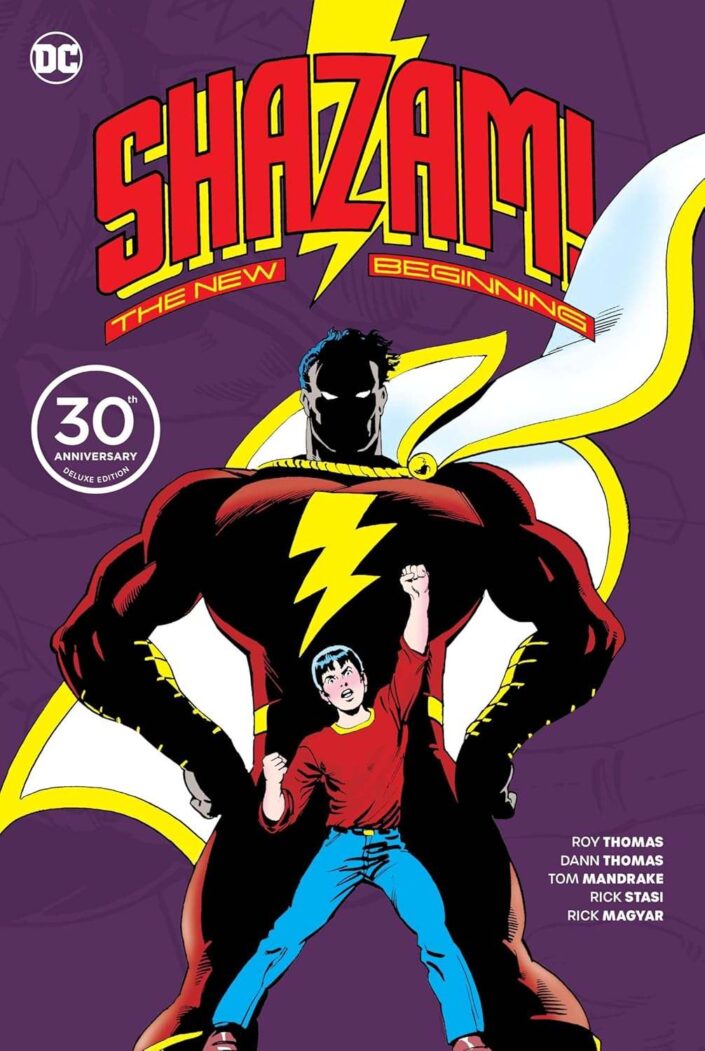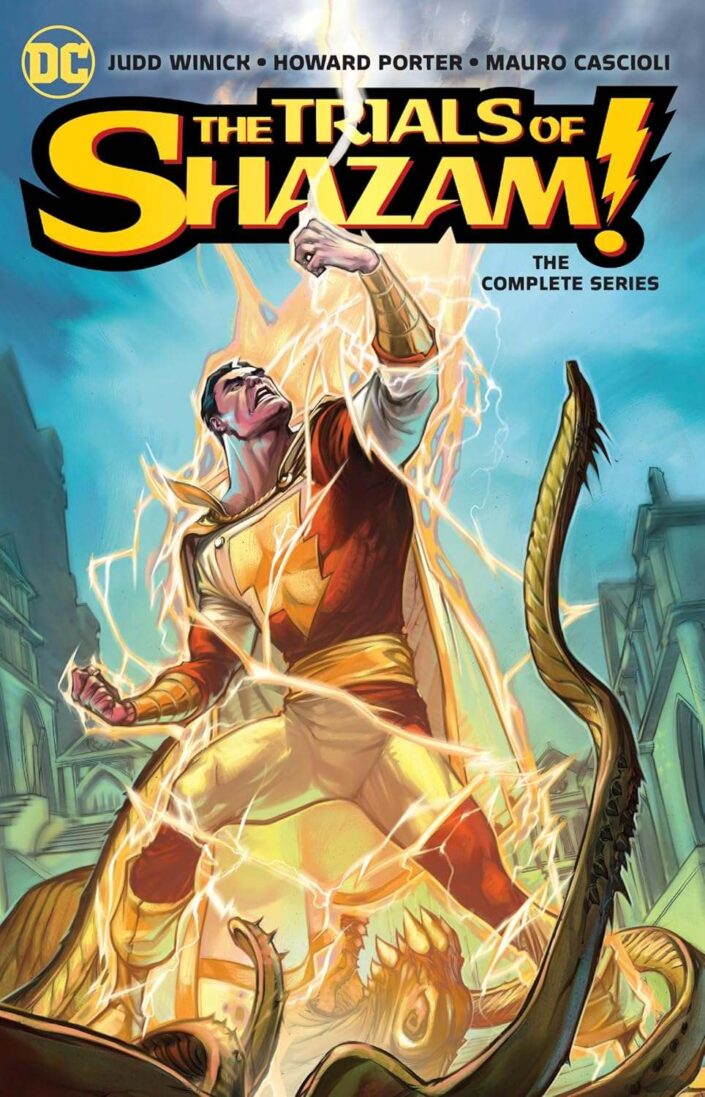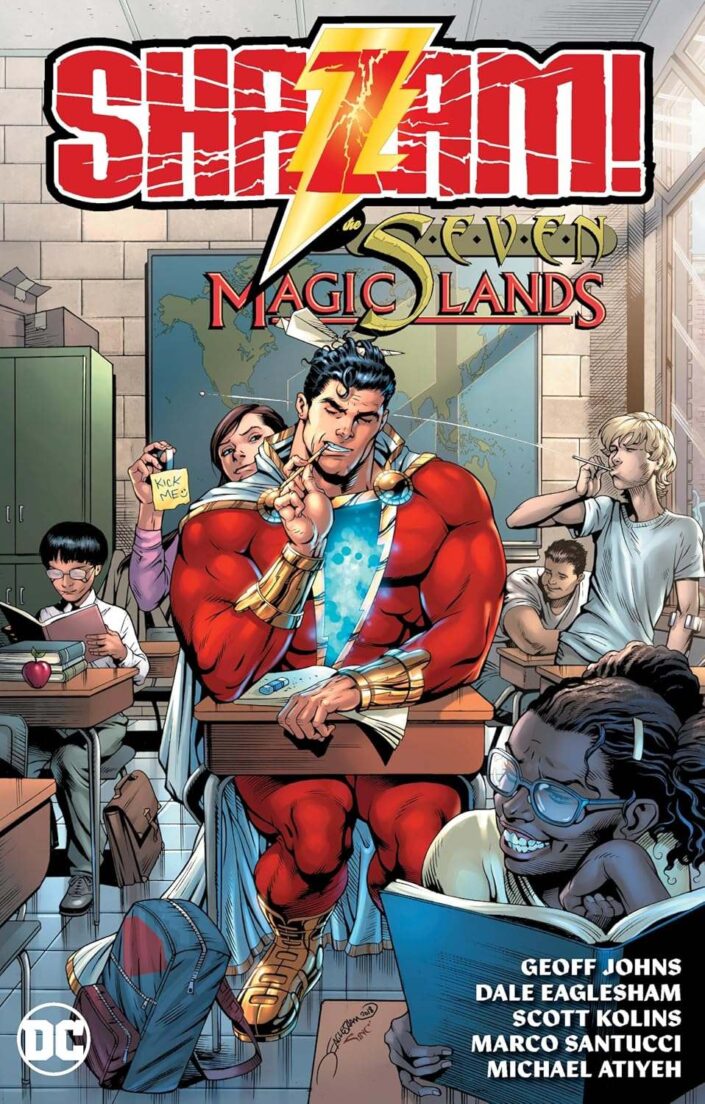
The history of Shazam, originally known as Captain Marvel, is one of the most legal-heavy in comic book history. The character was created by writer Bill Parker and artist C. C. Beck in 1939, debuting in Whiz Comics #2 (1940) under Fawcett Comics.
By the early 1940s, Captain Marvel had become the most popular superhero of the Golden Age, outselling even Superman. However, this success led to a legal battle when DC Comics sued Fawcett, alleging that Captain Marvel was an infringement on Superman’s character. After years of litigation, Fawcett ceased publishing Captain Marvel stories in 1953.
In 1972, DC Comics licensed the rights to the character, eventually purchasing them outright in 1991. However, by that time, Marvel Comics had secured the trademark for the name “Captain Marvel,” forcing DC to market the character and his associated heroes under the Shazam! banner from the 1970s onward.
Shazam’s story centers on Billy Batson, a 12-year-old orphan who is chosen by the ancient wizard Shazam to become Earth’s champion. By speaking the wizard’s name—an acronym representing the six mythological figures who empower him (Solomon, Hercules, Atlas, Zeus, Achilles, and Mercury)—Billy is transformed into the powerful adult superhero Captain Marvel.
Over time, he shares his abilities with his sister Mary Batson, and their friend Freddy Freeman, forming the Marvel Family, later rebranded as the Shazam Family. Together, they battle villains such as Doctor Sivana, Black Adam, and the sinister Mister Mind, leader of the Monster Society of Evil.
Shazam Reading Order
Shazam Comics from the Golden Age
We will mostly cover the DC Comics years, but if you are interested in exploring Captain Marvel/Shazam! comics by discovering his origins during the Fawcett years, you can start with this anniversary book:
- Shazam!: A Celebration of 75 Years
Collects Whiz Comics #2 & 21, Captain Marvel Adventures #18, 38-39, 137, 148, Captain Marvel, Jr. #12, Marvel Family #1, Hoppy the Marvel Bunny #6, Superman #276, Shazam! #1 & #29, World’s Finest #275, DC Comics Presents #49, L.E.G.I.O.N. #31, The Power of Shazam! #1-2, #33, Action Comics #768 , JSA #48, Shazam!: The Monster Society of Evil #2, Justice League (Volume 2) #21.
The next comic book is for the fans, an exploration of Captain Marvel/Shazam’s success with the collectibles! A beautiful book by award-winning writer/designer Chip Kidd and photographer Geoff Spear.
Shazam joined DC Comics (in the 1970s)
After a 20-year publication hiatus, in 1973, Captain Marvel came back in the Shazam comics with writers such as Denny O’Neil and arts by C.C. Beck (the original artist from the 1940s).
- Shazam!: The World’s Mightiest Mortal Vol. 1
Collects Shazam! #1-18. - Shazam!: The World’s Mightiest Mortal Vol. 2
Collects Shazam! #19-35 and All-New Collectors’ Edition #C-58. - Shazam!: The World’s Mightiest Mortal Vol. 3
Collects World’s Finest Comics #253-270 and 272-282, and Adventure Comics #491-492.
Shazam! Comics: The Post-Crisis Universe!
![]() In 1985, with the Crisis on Infinite Earths comics miniseries, the Shazam family was fully integrated into the DC Universe. This is an end and also the beginning of a new era for DC Comics. For more information about this massive event, take a look at our Crisis on Infinite Earths Reading Order.
In 1985, with the Crisis on Infinite Earths comics miniseries, the Shazam family was fully integrated into the DC Universe. This is an end and also the beginning of a new era for DC Comics. For more information about this massive event, take a look at our Crisis on Infinite Earths Reading Order.
- Crisis on Infinite Earths (the 2001 TPB edition)
Collects Crisis on Infinite Earths #1-12.
The first Post-Crisis appearance of Captain Marvel was in the Legends comics miniseries, published in 1986: “Out of the ashes of the greatest interdimensional holocaust comes a new generation of superheroes: Wonder Woman, the Suicide Squad, the Flash, and the all-new Justice League! But first, they must take on a fight to the finish with the deadly minions of Darkseid the Destroyer to earn the right to join Superman, Batman, Captain Marvel, and Green Lantern as the mightiest heroes of modern times. This is the story of…Legends!”
- Legends – 30th Anniversary Edition
Collects Legends #1-6.

Then, writers Roy and Dann Thomas and artist Tom Mandrake wrote an altered origin story for Shazam! to ease the character into the modern DC Comics Universe. Captain Marvel also briefly joined the Justice League International team (for the first storyline only).
- Shazam!: The New Beginning
Collects Shazam!: The New Beginning #1-4 and the Captain Marvel stories from Action Comics Weekly #623-626. - Justice League International Vol. 1
Collects Justice League #1-6 and Justice League International #7.
All of this led mostly nowhere at that time. The Shazam ongoing comics that was announced never saw the light of day. In 1991, Captain Marvel, the wizard Shazam, and Black Adam appeared in the War of the Gods (the Wonder Woman event). The next year, Shazam joined Superman in the Panic in the Sky storyline.
- Wonder Woman: War of the Gods
Collects War of the Gods #1-4, Wonder Woman #58-62, and Wonder Woman: War of the Gods. - Superman: Panic in the Sky
Collects Action Comics #674-676, Superman: Man of Steel #9-11, Adventures of Superman#488-490, Superman#65-67.
![]() Another Crisis level event! But an optional one for Captain Marvel and the Shazam Family. In fact, the character barely appeared in Zero Hour: Crisis in Time.
Another Crisis level event! But an optional one for Captain Marvel and the Shazam Family. In fact, the character barely appeared in Zero Hour: Crisis in Time.
![]()
Shazam! Comics: The Power of Shazam! (1990s)
In 1991, DC Comics charged Jerry Ordway with writing and illustrating an original graphic novel retconning Captain Marvel again (erasing what Shazam!: The New Beginning did) which was released… in 1994. Titled The Power of Shazam!, the comic book was a success and led to an ongoing series. Those Power of Shazam comics reintroduced the Marvel Family and many of their allies and enemies into the modern-day DC Universe.
- The Power of Shazam! Book 1: In the Beginning
Collects the Power of Shazam! graphic novel, The Power of Shazam #1-12.
In 2020, DC Comics started reprinting the series. For now, this is all that is available in hardback. You can still find the rest of the series in digital form.
Freddy Freeman aka Captain Marvel Jr appeared alongside the Teen Titans in a few issues:
- Teen Titans (1996) #4-5, 17-24
Available on Kindle & Comixology
- JLA, Vol. 5: Justice for All
Collects JLA #24–33. Captain Marvel appeared in the “Crisis Times Five” storyline (JLA #28-31) also available in JLA: The Deluxe Edition, Vol. 3.
![]() In 1996, Captain Marvel also appeared in Mark Waid and Alex Ross’s critically acclaimed alternate universe Elseworlds miniseries Kingdom Come (out of the continuity).
In 1996, Captain Marvel also appeared in Mark Waid and Alex Ross’s critically acclaimed alternate universe Elseworlds miniseries Kingdom Come (out of the continuity).
Written by Paul Dini with painted art by Alex Ross, the Shazam!: Power of Hope comics is a tale of a superhero using his powers in the most human of ways: to instill hope in the hearts of children.
- Shazam! Power of Hope
One shot recently reprinted in a hardcover edition.
![]()
Shazam! Comics: From the JSA to Infinite Crisis (the first half of the 2000s)
![]() The Superman/Shazam: First Thunder miniseries, written by Judd Winick with art by Josh Middleton, and published between September 2005 and March 2006, depicted the first post-Crisis meeting between Superman and Captain Marvel.
The Superman/Shazam: First Thunder miniseries, written by Judd Winick with art by Josh Middleton, and published between September 2005 and March 2006, depicted the first post-Crisis meeting between Superman and Captain Marvel.
- Superman/Shazam: First Thunder
Collects Superman/Shazam: First Thunder #1-4.
![]() The Power of Shazam! ongoing series was canceled in 1999. This time, the Marvel Family sticks around. In fact, Black Adam became one of the main characters in Geoff Johns’ and David S. Goyer’s JSA series. To keep an eye on him, Captain Marvel even joined the team for a while.
The Power of Shazam! ongoing series was canceled in 1999. This time, the Marvel Family sticks around. In fact, Black Adam became one of the main characters in Geoff Johns’ and David S. Goyer’s JSA series. To keep an eye on him, Captain Marvel even joined the team for a while.
- JSA, vol. 5: Stealing Thunder
Collects JSA #32–38 - JSA, vol. 6: Savage Times
Collects JSA #39–45 - JSA, vol. 7: Princes of Darkness
Collects JSA #46–55 - JSA, vol. 8: Black Reign
Collects JSA #56–58; Hawkman vol. 4 #23–25 - JSA, vol. 9: Lost
Collects JSA #59–67. Shazam left the JSA with #59
Double Crisis Alert! First, another optional one for Captain Marvel and the Shazam Family. They barely appeared in Identity Crisis. Then came Lightning Strikes Twice/Day of Vengeance, a storyline leading to Infinite Crisis. Outside of Day of Vengeance and the Day Of Vengeance: Infinite Crisis Special #1, Captain Marvel appeared mostly in the background, but Black Adam is a bit more visible.
- Day of Vengeance
Collects Day of Vengeance #1-6, Action Comics #826, The Adventures of Superman #639, and Superman #216.- JSA, vol. 10: Black Vengeance
Collects JSA #68–75. JSA #73-75 are Day of Vengeance tie-in issues.
- JSA, vol. 10: Black Vengeance
Freddy Freeman/Captain Marvel Jr. showed up in the Outsiders Vol. 3 written by Judd Winick, issues #9-10 and 28-33.
- Outsiders Vol. 2: Sum of all Evil
Collects Outsiders #8-15 - Outsiders Vol. 3: Wanted
Collects Outsiders #16-23 - Infinite Crisis
Collects Infinite Crisis #1–7.
Once the Crisis was completed, DC Comics used the “One Year Later” event to move the narratives of most of its DC Universe comics forward by… one year. Published weekly for one year, the 52 series consists of 52 issues, each issue detailing an actual week chronicling the events that took place during the missing year. Shazam/Captain Marvel makes some appearances, but Black Adam and his expanded family occupy more space.
- 52 Omnibus
Collects 52 #1-52.
Written and illustrated by Jeff Smith (creator of Bone), Shazam: Monster Society of Evil is an out-of-continuity for-all-ages miniseries published in 2007.
- Shazam: Monster Society of Evil
Collects Shazam: Monster Society of Evil #1-4.
![]()
Shazam! Comics: From The Trials of Shazam! to the Final Crisis
Written by Judd Winick and illustrated by Howard Porter and Mauro Cascioli, The Trials of Shazam! is a twelve-issue limited series. Dealing with the aftermath of Infinite Crisis (set up with the one-shot DCU: Brave New World), the story sees Billy Batson/Captain Marvel changing his name to “Marvel” as he became the caretaker of the remains of the Rock of Eternity. Freddy Freeman (Captain Marvel Jr) must prove himself worthy of replacing Captain Marvel.
- The Trials of Shazam: The Complete Series
Collects The Trials of Shazam! #1-12.
Starting mostly at the same time as The Trials of Shazam, Countdown to Final Crisis follows 52, same concept, but more about Mary Marvel this time around.
- Countdown to Final Crisis vol. 1
Collects Countdown #51-39. - Countdown to Final Crisis vol. 2
Collects Countdown #38-26. - Countdown to Final Crisis vol. 3
Collects Countdown #25-13. - Countdown to Final Crisis vol. 4
Collects Countdown #12-1.

Crisis Alert! Another Crisis event, but this one is more important for Captain Marvel, Black Adam, and Mary Marvel. You can find more information in our guide to reading the Final Crisis comics in order.
- Final Crisis
collects DC Universe #0, Final Crisis #1-7, Final Crisis: Superman Beyond #1-2, Final Crisis: Submit #1, Batman #682-683
For the end of the Mary Marvel story, it’s back in the pages of the JSA:
- Justice Society of America: Black Adam and Isis
Collects JSA (vol.3) #23-28.
Billy and Mary Batson made a brief appearance during the Blackest Night saga in a one-shot special, The Power of Shazam! #48 – collected in Blackest Night: Rise of the Black Lanterns.
In 2011, Eric Wallace wrote a one-shot simply titled “Shazam!” After years as the World’s Mightiest Mortals, Billy and Mary Batson no longer wield the power of SHAZAM. But when Blaze, the current ruler of Hell, offers them a chance to regain the power they lost, will they take it–even at the cost of their friend and current Shazam Freddie Freeman? The story of Freddie is concluded in the pages of Titans (vol. 2) #32.
- Titans vol. 5: Family Reunion
Collects Titans vol. 2 #28–32, Shazam! #1
Following Shazam: Monster Society of Evil by Jeff Smith, DC Comics launched another cartoony-for-all-ages Shazam series titled Billy Batson and the Magic of Shazam! as a part of its Johnny DC imprint. It was originally written and drawn by Mike Kunkel.
- Billy Batson and the Magic of Shazam! Family Affair
Collects Billy Batson and the Magic of Shazam! #1–12 - See here for #13-21.
![]()
Shazam! Comics during the New 52 Era
In 2011, DC Comics rebooted its continuity and entered the New 52 era with the help of the crossover event title Flashpoint (see reading order for more details). It introduced a new timeline in which the Shazam Family was expanded. Billy, Mary, and Freddy Freeman were joined by Eugene Choi, Pedro Peña, and Darla Dudley. Of course, the Flashpoint Timeline was not the main one, but the kids were reintroduced later in the new continuity.
- Flashpoint
Collects Flashpoint #1-5.
At first, Captain Marvel and the Shazam Family didn’t get their own comic book series, they came back with backup stories written by Geoff Johns and drawn by Gary Frank published in the Justice League (vol. 2) comics. In this new incarnation, it was decided to stop using the “Captain Marvel” name. Now, he was simply “Shazam.”
- Shazam! Vol. 1 (The New 52): From the Pages of Justice League
Collects Justice League #0, 21 and stories from Justice League#7-11, 14-16, 18-20.
After that, the Shazam Family had a role to play during the Trinity War/Forever Evil events (see reading order for more details), then Captain Marvel joined the Justice League and briefly became a supporting character in the Cyborg comics.
- Justice League: Trinity War
Collects Free Comic Book Day 2012, Trinity Of Sin: Pandora 1-3, Trinity Of Sin: Phantom Stranger 11, Justice League 22-23, Justice League Dark 22-23, Justice League Of America 6-7, and Constantine 5- Forever Evil – The follow-up of Trinity War with Black Adam, but almost no Shazam.
Collects Forever Evil #1-7
- Forever Evil – The follow-up of Trinity War with Black Adam, but almost no Shazam.
- Justice League Vol. 6: Injustice League
Collects Justice League #30-39 - Justice League: The Darkseid War (DC Essential Edition)
Collects Justice League #40-50, Justice League: The Darkseid War Special, and DC Sneak Peek: Justice League. For more about The Darkseid War, see the reading order.
- Cyborg vol. 2: Enemy of the State
Collects Cyborg vol. 1 #7–12, Cyborg: Rebirth #1
Shazam on other Earths
In Grant Morrison’s 2014 miniseries The Multiversity, the story takes place on the parallel world of Earth-5 that offers new takes on the classic Fawcett versions of Captain Marvel and the Marvel Family.
- The Multiversity: Thunderworld Adventures #1
Collected in The Multiversity
During the Convergence event, the story takes place on the parallel world of Earth-S.
- Convergence: Infinite Earths Book Two
Collects Shazam! #1-2, Blue Beetle #1-2, Crime Syndicate #1-2, Convergence: Booster Gold #1-2 And Plastic Man And The Freedom Fighters #1-2
![]()
Shazam! Comics: From the Rebirth era to today
In 2016, DC Comics organized a soft relaunch with DC Rebirth. Captain Marvel and the Shazam Family were not really represented. Black Adam made an appearance in Dark Nights: Metal #4-5 (see our article about the event). But in 2018, with the Shazam! movie in production, DC decided to bring back the superhero in a new ongoing Shazam! comics, written by Geoff Johns and illustrated by Dale Eaglesham, Marco Santucci, and Scott Kolins.
- Shazam and The Seven Magic Lands
Collects Shazam #1-11 and #13-14.

After Dark Nights: Death Metal, DC Comics launched Future State, an exploration of a possible future. Then came a new era: Infinite Frontier during which he got a new miniseries.
- Future State: Suicide Squad
Collects Future State: Suicide Squad #1-2, Future State: Teen Titans: Dead of the Class #1-2, Future State: Shazam!: The Death of William Batson #1-2 (now also in Shazam!: To Hell and Back), and Future State: Swamp Thing: Obsidian Sun #1-2. - Teen Titans Academy 1: X Marks the Spot (Only Billy Batson appeared in the series, but it led to the next Shazam! miniseries)
Collects Teen Titans Academy #1-5, Teen Titans Academy 2021 Yearbook #1, Infinite Frontier #0, and Suicide Squad #3. - Shazam!: To Hell and Back
Collects Shazam! (2021) #1-4 and Future State: Shazam! #1-2. - The New Champion of Shazam!
Collects The New Champion of Shazam! #1-4 and material from Lazarus Planet: We Once Were Gods #1!
Following the Lazarus Planet event, the status quo is changed for the Shazam Family as seen in the Lazarus Planet Revenge of the Gods miniseries:
- Lazarus Planet Revenge of the Gods
Collects Lazarus Planet: We Once Were Gods #1, Lazarus Planet Revenge of the Gods #1-4, and Wonder Woman #797-798. - Knight Terrors: Terror Titans
Collects Knight Terrors: Titans #1-2, Knight Terrors: Shazam! #1-2, Knight Terrors: Black Adam #1-2, Knight Terrors: Angel Breaker #1-2, and Knight Terrors: Ravager #1-2.
With the second Shazam movie coming out, DC Comics published Shazam! Fury of the Gods Special – Shazamily Matters #1, anthology prequel to the movie Shazam!: Fury of the Gods. It is not in continuity.
As DC Comics transitioned from the Infinite Frontier era to the Dawn of DC era, a new Shazam! comics by Mark Waid and Dan Mora is launched. It brings Billy Batson back as The Captain “in the action-comedy comic about a boy with powers that rival Superman’s and a whole lot of growing up left to do.”
- Shazam! Vol. 1: Meet the Captain
Collects Shazam! (2023) #1-6 - Shazam! Vol. 2: Moving Day
Collects Shazam! (2023) #7-12. - Shazam! Vol. 3: Where in the World is Billy Batson?
Collects Shazam! (2023) #13-16, Wonder Woman #11, and Absolute Power: Task Force VII #1 (see Absolute Power for more info about these last two issues).
With Shazam! #16, the comics officially entered the DC All In era.
More Shazam Comics Coming Soon…
Did we forget an important issue? Did we make a mistake? Let us know in the comments!